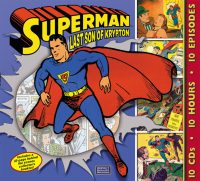
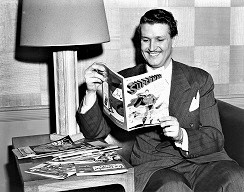 The Adventures of Superman (1940-1951) aired “The Mystery of the Walking Dead” on October 29, 1949 as the 62nd episode of its run in the 1949 season (all of which from February to December save one were of the half hour variety as opposed to the many multi-part, 15-minute serials that ran through most of the 1940s). Since we’ve showcased only six other episodes of this program (the last two being in September of 2022 and April of 2023) I felt it would be helpful for newcomers to this fun adventure series if I reprised the generic background information that preceded these earlier episodes.
The Adventures of Superman (1940-1951) aired “The Mystery of the Walking Dead” on October 29, 1949 as the 62nd episode of its run in the 1949 season (all of which from February to December save one were of the half hour variety as opposed to the many multi-part, 15-minute serials that ran through most of the 1940s). Since we’ve showcased only six other episodes of this program (the last two being in September of 2022 and April of 2023) I felt it would be helpful for newcomers to this fun adventure series if I reprised the generic background information that preceded these earlier episodes.
[The linked CD at top includes “The Mystery of the Walking Dead.”]
The Superman character, created by Jerry Siegel and Joe Shuster, first appeared in Action Comics #1, dated June 1938. That superhero strip in the comic was one of several strips in that now famous first issue, but turned out to be popular enough that a newspaper comic strip debuted in 1939. It also proved immensely popular, popular enough that a stand alone comic book was spun off and added to the ever-growing franchise, with the now iconic title of Superman #1, with a cover date of Summer 1939 (cover below left).
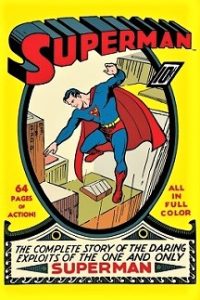 But the comic strip and magazine were only the beginning for the Man of Steel. Things were moving quickly, and as Wikipedia explains: “The serial came to radio as a syndicated show on New York City’s WOR on February 12, 1940. On Mutual, it was broadcast from August 31, 1942, to February 4, 1949, as a 15-minute serial, running three or, usually, five times a week. From February 7 to June 24, 1949, it ran as a thrice-weekly half-hour show. The series shifted to ABC Saturday evenings on October 29, 1949, and then returned to afternoons twice a week on June 5, 1950, continuing on ABC until March 1, 1951. In all, 2,088 original episodes of The Adventures of Superman aired on American radio.” Wikipedia also notes that many of the elements that have become staples of Superman’s fictional world were first introduced in the radio show, among them kryptonite, Daily Planet editor Perry White, copy boy (later cub reporter) Jimmy Olsen, and police inspector Bill Henderson. Also worthy of mention is the first meeting between Superman and Batman (and Robin) which took place in the March 2, 1945 episode.
But the comic strip and magazine were only the beginning for the Man of Steel. Things were moving quickly, and as Wikipedia explains: “The serial came to radio as a syndicated show on New York City’s WOR on February 12, 1940. On Mutual, it was broadcast from August 31, 1942, to February 4, 1949, as a 15-minute serial, running three or, usually, five times a week. From February 7 to June 24, 1949, it ran as a thrice-weekly half-hour show. The series shifted to ABC Saturday evenings on October 29, 1949, and then returned to afternoons twice a week on June 5, 1950, continuing on ABC until March 1, 1951. In all, 2,088 original episodes of The Adventures of Superman aired on American radio.” Wikipedia also notes that many of the elements that have become staples of Superman’s fictional world were first introduced in the radio show, among them kryptonite, Daily Planet editor Perry White, copy boy (later cub reporter) Jimmy Olsen, and police inspector Bill Henderson. Also worthy of mention is the first meeting between Superman and Batman (and Robin) which took place in the March 2, 1945 episode.
Bud Collyer (1908-1969, photo top right) was the voice of Clark Kent and Superman on radio, lowering his voice slightly when speaking as the Man of Steel. He is arguably best known, however, as the host of the popular television game shows of the 1950s, Beat the Clock and To Tell the Truth.
Joan Alexander (1915-2009, birth name Louise Abrass) played the spunky Lois Lane character for more than one thousand episodes of the program’s 11-year run.
From 1940-47 Jack Kelk (1923-2002) would play Jimmy Olsen, and from 1948-1950 it was Jack Grimes (1926-2009) who would play Jimmy Olsen. An interesting bit of trivia concerning Grimes is that though he was an old man of 22 when he began playing Jimmy Olsen, by the age of 12 he was acting in 35-40 radio shows a week. Grimes also worked in film and television in later years. A film of note in which he appeared was 1945’s noir crime film Lady on a Train (starring Deanna Durbin and Ralph Bellamy), based on the Leslie Charteris story. His television work included roles in Tom Corbett, Space Cadet, Maude, and All in the Family.
(Left: Joan Alexander – Center: Jack Kelk – Right: Jack Grimes)
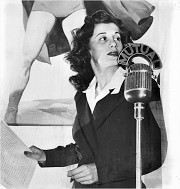
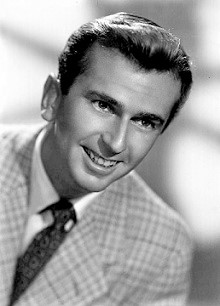
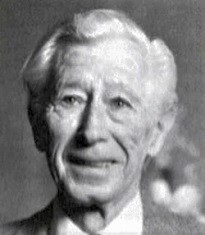
“The Mystery of the Walking Dead” begins with a condemned convict’s last request being that Lois come to the prison where he is about to be executed to listen to his final thoughts. Against Clark’s strident objections Lois agrees. While listening to what seems at first to be the quiet madness of the criminal known as Krishna, Lois becomes somehow emotionally seduced, even hypnotized by the man’s promise to return from the dead, to the point where she becomes an emotional wreck. Not buying into any of the obviously insane criminal’s rantings Clark tries his best to console Lois, but to no avail. Later that evening, Lois and Clark attend a social event where something transpires that…but no, this would be giving away far too much and would not convey the very real physical trauma of the dark situation Lois finds herself in, where death most certainly awaits her…until Superman arrives to save his favorite gal reporter. It’s actually a quite decent episode, revealing not only to Lois but the listener as well the truth behind “The Mystery of the Walking Dead.”
Play Time: 29:51
{This episode was the first of ABC’s tenure as sponsor and was now broadcast on Saturday evenings at 8:30, proving to be a perfect bit of scheduling to capture both young listeners and more adult fans of the Man of Steel to which these new episodes were also aimed. After the trip home from church the following morning and a change of clothes, the neighborhood gang was off to the nearby newsstand for further exciting adventures like the previous evenings Superman tale. Famous Fantastic Mysteries (1939-53) began as an experiment. It reprinted classic scientific and fantastic stories from the years before there was such a thing as SF or Fantasy magazines, but stories so initially well received that the publisher, and editor Mary Gnaedinger, felt they should be available to new generations of readers. After the first issue was a rousing success the rest was history. Over its 81 issue run the magazine would publish from well known authors as well as those one might not associate with the core “fantasy” story. A few examples from both ends of the spectrum included such as A. Merritt, H. Rider Haggard and Talbot Mundy on one end, and Ayn Rand and Sax Rohmer on the other, the latter pair the editor wisely chose to introduce to her newer readers. Famous Fantastic Mysteries was a bi-monthly in 1949. Fantastic Novels (1940-41, 1948-51) was the companion magazine to Famous Fantastic Mysteries and was brought to life by a multitude of fan requests for more in the same vein but at novel length. Such legendary fantasists as A. Merritt would appear frequently, alongside other well known names of the time like Murray Leinster, Ray Cummings, and Austin Hall & Homer Eon Flint. Fantastic Novels was also a bi-monthly in 1949. Super Science Stories (1940-43, 1949-51) was launched on a shoestring with Fred Pohl as editor. Though the pay was extremely low Pohl managed to convince enough of his young friends like Isaac Asimov, Henry Kuttner and Jack Williamson among others to contribute. Pohl left the magazine in 1943 to join the army. In its second incarnation begun in 1949, Ejler Jakobsson was the editor. While offering new material from popular authors like Ray Bradbury, Poul Anderson, and A. E. van Vogt, he also ran quite a number of reprints over the magazine’s final three-year stint. Super Science Stories managed 5 stories in 1949 as it transitioned from a quarterly to a bi-monthly with its last 3 issues.}
[Left: Famous Fantastic Mysteries, 10/49 – Center: Fantastic Novels, 11/49 – Right: Super Science Stories, 9/49]
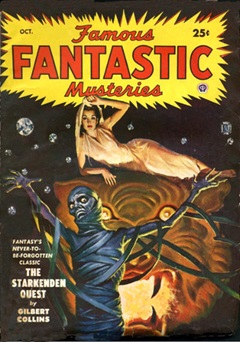
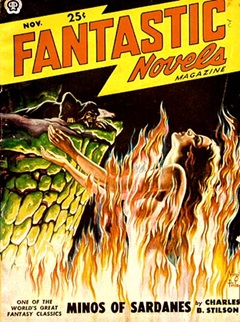
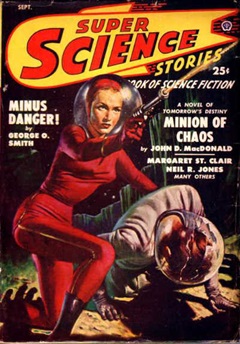
To view the entire list of weekly Old Time Radio episodes at Tangent Online, click here.